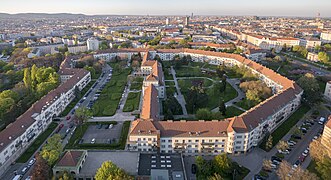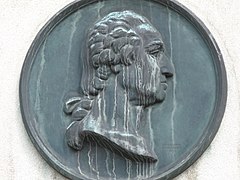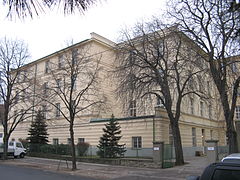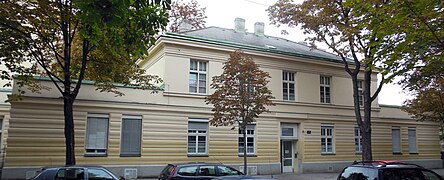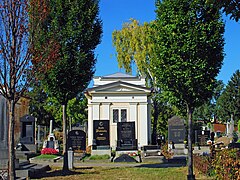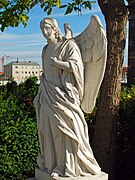Unter-Meidlinger Strasse
| Unter-Meidlinger Strasse | |
|---|---|
| Street in Vienna | |
| Unter-Meidlinger Strasse at Kastanienallee | |
| Basic data | |
| place | Vienna |
| District | 10th district , 12th district |
| Created | 1905 |
| Connecting roads | Eschenallee |
| Cross streets | Karplusgasse, Fliederhof, Köglergasse, Rotdornallee, Kastanienallee, Moosbruggergasse, Eibesbrunnergasse, Pirkebnerstraße, Cothmannstraße, Wurmbstraße, Haidäckergasse, Pottendorfer Straße |
| Buildings | George-Washington-Hof , Meidling Rehabilitation Center , Meidlinger Friedhof |
| use | |
| User groups | Pedestrians , bicycle traffic , car traffic , bus routes 7B 63A |
| Road design | avenue |
| Technical specifications | |
| Street length | approx. 1416 m |
The sub-Meidlinger Street is a side street in east-west direction in the Vienna municipal districts favorites and Meidling . It was named in 1905 after the former suburb of Untermeidling , which included the part of the historic town of Meidling closer to the city center and stretched from the Wiental to this point.
Location and characteristics
Unter-Meidlinger Strasse runs across the slope of Wienerberg from Triester Strasse (opposite the confluence of Raxstrasse ) in the east to the Pottendorfer line in the cut in the west (over which there is a pedestrian bridge to the Philadelphiabrücke underground station and the Vienna Meidling train station hat), mostly parallel to the one or two blocks further south running through road Wienerbergstraße (B 225). It is an avenue that touches quiet residential areas, largely with little traffic. (The central part of the district north of the Südbahn is lower, Wienerbergstrasse runs along the ridge.)
Public transport is available next to the high-speed lines that can be reached at the Philadelphiabrücke
- the bus line 63A, which connects the central part of the street with the underground stations Niederhofstraße (U6) and Meidling Hauptstraße (U4) in the Wiental in a south-north direction, and
- Line 7A, which connects the Reumannplatz (U1) and Philadelphiabrücke (U6) underground stations in an east-west direction and crosses Unter-Meidlinger Straße.
From Kundratstrasse , Unter-Meidlinger Strasse runs eastwards as a one-way street . However, it is not continuously drivable to Triester Straße, as the car traffic is forwarded to Karplusgasse, while the first section of Unter-Meidlinger Straße coming from the Fliederhof is used again.
A cycle path runs from Triester Straße to Eibesbrunnergasse.
Remarkable structures
No. 1: George Washington Court
At Triester Strasse, Unter-Meidlinger Strasse initially leads in a right-hand curve around and through the main portal of the George-Washington-Hof and then on its north side in an east-west direction. The main portal has a portrait relief depicting the first US President, George Washington .
The large community building comprises a total of 1084 apartments. Birkenhof, Fliederhof and Ahornhof were designed by Karl Krist , Ulmenhof and Akazienhof by Robert Oerley . The facility, built between 1927 and 1930, was named after him in 1932, on the 200th birthday of the statesman. Originally the project was called Am Wienerberg - Spinner on the Cross , as this Gothic stone column is located a few meters in the center of the junction of Unter-Meidlinger Straße on Triester Straße.
While there are some outlying buildings on the right side of the street, the Birkenhof and the Fliederhof are on the left, then the Ahornhof. Then, along Köglergasse, the district border runs between Favoriten and Meidling; Unter-Meidlinger Straße leaves the 10th district of Vienna here. Ulmenhof and Akazienhof already belong to the 12th district. During the February fighting in 1934, the command center of the Republican Protection Association was located in the Ulmenhof, a memorial plaque commemorates this.
No. 26: Meidling Rehabilitation Center
Across from Ulmenhof and Akazienhof, at the corner of Köglergasse 2A, is the Meidling Rehabilitation Center , which was built by Gustav Peichl in 1966–1968 . Following this on the left at no. 28 you can see the rear of the Meidling Accident Hospital (entrance: Kundratstrasse 37–39; architect not identified).
No. 63: Asylum for the homeless
After the western end of the George-Washington-Hof, on the corner of Kastanienallee (the former Asylgasse), there is the “Asylum for the Homeless” building. It was built in 1908 by Karl Krepp , Friedrich Mahler and Albrecht Michler for the private "Asylum Association". In 1909, the association moved to the new building, where it was originally able to offer 1,100 beds for the homeless. Adolf Hitler lived here from November to December 1909 , but according to the latest research this is no longer considered certain.
The building was later used to house refugees. Since the 1980s homeless families have been accommodated in the Kastanienallee building. The listed building was subdivided and structurally changed in 2007 and 2009, but the exterior facade was completely preserved. Since 2007, only the U63 male emergency sleeping area has been accessible from Unter-Meidlinger Straße. The House for Asylum is the oldest building in Vienna, which was built as a shelter for the homeless and is still used for this purpose today.
No. 79–83: Housing complex
On the residential complex there are two sgraffiti by Leopold Christian Pfeffer with the title The joys of the little man . One is gardening, the other is sport. Both pictures were taken in 1953.
Meidlinger Friedhof
About half the length of the north side of the street, from Kundratstrasse / Kastanienallee westwards to the Pottendorfer line, is taken up by the Meidlinger Friedhof , but without an entrance. The cemetery consists of two parts, which are separated from the Eibesbrunnergasse, which crosses Unter-Meidlinger Straße. It was opened in 1862 and is one of the larger ones in Vienna. The great school reformer of Red Vienna , Otto Glöckel , is buried here, otherwise there are mainly burial sites for locally important people such as Josef Leopold Gierster and Karl Hilscher .
literature
- Dehio Handbook Vienna. X. to XIX. and XXI. to XXIII. District . Verlag Anton Schroll: Wien, 1996
Web links
Individual evidence
- ↑ Architekturlexikon Wien: Public Buildings by Friedrich Mahler: Asylum for the Homeless , accessed on June 26, 2012
- ↑ Diploma thesis: On the edge of society. Homelessness in a historical context and an analysis of the present. Page 49 (PDF; 5.6 MB), accessed June 14, 2012
- ↑ Bezirksmuseum.at: Bed-walkers in Vienna and Mariahilf. Pp. 9-10 , accessed June 14, 2012
- ↑ Wiener Zeitung: Lived Hittler ever in a homeless shelter? , accessed June 14. 2012
- ↑ Fund Social Vienna: Assisted Living ( Memento of the original from May 21, 2012 in the Internet Archive ) Info: The archive link has been inserted automatically and has not yet been checked. Please check the original and archive link according to the instructions and then remove this notice. , accessed April 15, 2012
- ↑ Wiederwohnen: General Information Kastanienallee ( page no longer available , search in web archives ) Info: The link was automatically marked as defective. Please check the link according to the instructions and then remove this notice. (PDF; 270 kB), accessed on June 23, 2012
- ^ Caritas: General information about the U63 , accessed on April 15, 2012
Coordinates: 48 ° 10 ′ 19.9 ″ N , 16 ° 20 ′ 22.7 ″ E


